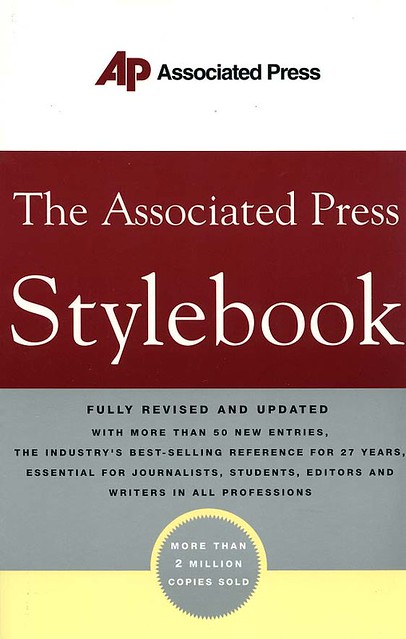Potsticker or Pot Sticker? The AP Stylebook's New Food Section Tells You What's Up. But Not Everything.

Food writing with "style"!
“With all the cooking shows, blogs and magazines focusing on food, as well as growing interest in organic and locally sourced foods, our new food section feels timely and on trend,” said Colleen Newvine, product manager of the AP Stylebook. “With this new addition to the AP Stylebook, The Associated Press is proud to bring clarity to the writing that describes and informs the new food movement.”
“Whether it’s for blogs, books or mainstream media, good food writing demands a solid grasp of confusing and sometimes contradictory language. It made sense to use the AP’s expertise in setting the standards,” added J.M. Hirsch, AP food editor. “This new food section in the AP Stylebook reflects what we see anecdotally as a growing national interest in food writing and the need to answer language-based questions associated with that writing.”
Yes, indeed. But where was AP when I first started foodblogging back in 2004...er, wait a minute,...is foodblogging one word, two words, hyphenated?? Well, shoot, that's not covered in the new food section of the freshest, 2011 Edition of the AP Stylebook. However, there are plenty of other things clarified and consecrated in the rulebook: busboy is one word, Grape-Nuts is hyphenated, wheat germ is two words while wheatgrass is one.
Furthermore, under "Common Culinary Conversions" (Ooh, I love good alliteration! Gets my naughty nipples nimble!), AP Stylebook confirms that 1 stick butter = 1⁄2 cup = 8 tablespoons = 4 ounces.
Also, when writing a recipe, AP advises, "Begin sentences with equipment and technique, rather than ingredients. In a medium saucepan over low heat, whisk together the butter and sugar."
Rarely do I post recipes, but I occasionally have (like for my Peanut Butter & Jellyfish sandwich). But what I really needed guidance on was food words. The AP Stylebook does help users navigate through some of the culinary clutter out there, sort of.
Locavore: The preferred term for a person who strives to eat locally produced foods.
Adobo sauce: A spicy red sauce made from chilies, herbs and vinegar that is common to Mexican cooking.
Amuse-bouche: French, a bite-sized dish served at restaurants before the meal, usually free.
Blind bake: To bake the crust of a pie before filling it.
Farmstead: Generally used to describe a cheese produced solely from the milk of one farm.
Ghee: A clarified butter used in Indian cooking.
Orecchiette: A small, disk-like pasta.
Sashimi: A Japanese dish of thinly sliced raw seafood.
Huitlacoche: Also called corn smut. A fungus that grows on corn. Considered a delicacy of Mexican cuisine, it has a smoky-sweet flavor.
God bless the AP Stylebook for that last one because I was tearing my hair out and almost got into fist fights with hardcore Mexican nationals over it. Thanks to AP Stylebook, now I won't have to argue with anyone whether corn smut is spelled "huitlacoche" or "cuitlacoche" because AP told me what's up! Whether the word begins with an "h" or a "c", it's still "raven's shit" to me (the literal Nahuatl translation for huitlacoche).

What says "quack" and is gooey? Not this!
The only bane in my food writing world that did not get resolved with the new AP Stylebook food section is the delicious, saltwater bivalve mollusk the world insists on spelling as geoduck yet pronounces "gooey duck". No, this huge clam with a phallic siphon is neither a duck nor gooey. But it is tasty, especially served as sashimi (see AP definition above) — slick, crunchy and sweet! So, AP Stylebook, get on the stick and do something about the infuriating word geoduck. Or else there will surely be an uprising.
Ultimately though, it's great to see a highly regarded organization like AP finally representing the food world. And for that I give the AP Stylebook's new food section a high five! Or is it a high-five?
Comments